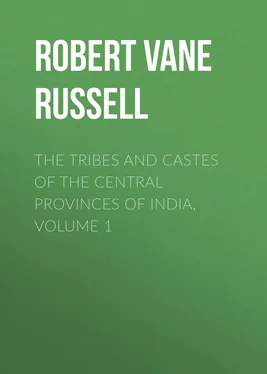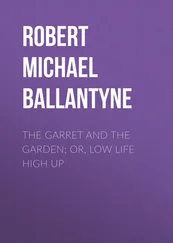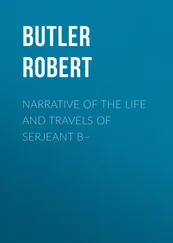Robert Vane Russell - The Tribes and Castes of the Central Provinces of India, Volume 1
Здесь есть возможность читать онлайн «Robert Vane Russell - The Tribes and Castes of the Central Provinces of India, Volume 1» — ознакомительный отрывок электронной книги совершенно бесплатно, а после прочтения отрывка купить полную версию. В некоторых случаях можно слушать аудио, скачать через торрент в формате fb2 и присутствует краткое содержание. Жанр: foreign_prose, История, foreign_edu, foreign_antique, на английском языке. Описание произведения, (предисловие) а так же отзывы посетителей доступны на портале библиотеки ЛибКат.
- Название:The Tribes and Castes of the Central Provinces of India, Volume 1
- Автор:
- Жанр:
- Год:неизвестен
- ISBN:нет данных
- Рейтинг книги:5 / 5. Голосов: 1
-
Избранное:Добавить в избранное
- Отзывы:
-
Ваша оценка:
- 100
- 1
- 2
- 3
- 4
- 5
The Tribes and Castes of the Central Provinces of India, Volume 1: краткое содержание, описание и аннотация
Предлагаем к чтению аннотацию, описание, краткое содержание или предисловие (зависит от того, что написал сам автор книги «The Tribes and Castes of the Central Provinces of India, Volume 1»). Если вы не нашли необходимую информацию о книге — напишите в комментариях, мы постараемся отыскать её.
The Tribes and Castes of the Central Provinces of India, Volume 1 — читать онлайн ознакомительный отрывок
Ниже представлен текст книги, разбитый по страницам. Система сохранения места последней прочитанной страницы, позволяет с удобством читать онлайн бесплатно книгу «The Tribes and Castes of the Central Provinces of India, Volume 1», без необходимости каждый раз заново искать на чём Вы остановились. Поставьте закладку, и сможете в любой момент перейти на страницу, на которой закончили чтение.
Интервал:
Закладка:
39. Of the Dravidian tribes
The Dravidian languages, Gondi, Kurukh and Khond, are of one family with Tamil, Telugu, Malayalam and Canarese, and their home is the south of India. The word Dravida comes from an older form Damila or Dramila, and was used in ancient Pali and Jain literature as a name for the people of the Tamil country. 75 75 Linguistic Survey , p. 277.
Afterwards it came to signify generally the people of southern India as opposed to Gaur or northern India.
As stated by Sir Edward Gait there is at present no evidence to show that the Dravidians came to southern India from any other part of the world, and for anything that is known to the contrary the languages may have originated there. The existence of the small Brahui tribe in Baluchistān who speak a Dravidian language but have no physical resemblance to other Dravidian races cannot be satisfactorily explained, but, as he points out, this is no reason for holding that the whole body of speakers of Dravidian languages entered India from the north-west, and, with the exception of this small group of Brahuis, penetrated to the south and settled there without leaving any traces of their passage.
The Dravidian languages occupy a large area in Madras, Mysore and Hyderābād, and they extend north into the Central Provinces and Chota Nāgpur where they die out, practically not being found west and north of this tract. As the languages are more highly developed and the culture of their speakers is far more advanced in the south, it is justifiable to suppose, pending evidence to the contrary, that the south is their home and that they have spread thence as far north as the Central Provinces. The Gonds and Oraons, too, have stories to the effect that they came from the south. The belief has hitherto been, at least in the Central Provinces, that both the Gonds and Baigas have been settled in this territory for an indefinite period, that is, from prior to any Aryan or Hindu immigration. Mr. H.A. Crump, C.S., has however pointed out that if this was the case the Munda or Kolarian tribes, which have lost their own languages, should have adopted Dravidian and not Hindu forms of speech. As already seen, numerous Kolarian tribes, as the Binjhwār, Bhaina, Bhuiya, Baiga, Bhumij, Chero, Khairwār and the Kols themselves in the Central Provinces have entirely lost their own languages, as well as the Bhīls and Kolis, if these are held to be Kolarian tribes. None of them have adopted a Dravidian language, but all speak corrupt forms of the ancient Aryan vernaculars derived from Sanskrit. The fact seems to indicate that at the time when they abandoned their own languages these tribes were in contact with Hindus, and were not surrounded by Gonds, as several of them are at present. The history of the Central Provinces affords considerable support to the view that the Gond immigration occurred at a comparatively late period, perhaps in the ninth or tenth century, or even later, after a considerable part of the Province had been governed for some centuries by Rājpūt dynasties. 76 76 See for this the article on Kol, from which the above passage is abridged.
The Gonds and Oraons still have well-defined legends about their immigration, which would scarcely be the case if it had occurred twenty centuries or more ago.
Any further evidence or argument as to the date of the Dravidian immigration would be of considerable interest.
40. Origin of the impure castes
The fifth or lowest group in the scheme of precedence is that of the impure castes who cannot be touched. If a high-caste Hindu touches one of them he should bathe and have his clothes washed. These castes are not usually allowed to live inside a Hindu village, but have a hamlet to themselves adjoining it. The village barber will not shave them, nor the washerman wash their clothes. They usually have a separate well assigned to them from which to draw water, and if the village has only one well, one side of it is allotted to them and the Hindus take water from the other side. Formerly they were subjected to more humiliating restrictions. In Bombay a Mahār might not spit on the ground lest a Hindu should be polluted by touching it with his foot, but had to hang an earthen pot round his neck to hold his spittle. He was made to drag a thorny branch with him to brush out his footsteps, and when a Brāhman came by had to lie at a distance on his face lest his shadow might fall on the Brāhman. 77 77 Bombay Gazetteer, vol. xii. p. 175.
Even if the shadow of a Mahār or Māng fell on a Brāhman he was polluted and dare not taste food and water until he had bathed and washed the impurity away. In Madras a Paraiyān or Pariah pollutes a high-caste Hindu by approaching within a distance of 64 feet of him. 78 78 Cochin Census Report , 1901, quoted in Sir H. Risley’s Peoples of India , 2nd ed. p. 115.
The debased and servile position of the impure castes corresponds to that which, as already seen, attached to the Sūdras of the classical period. The castes usually regarded as impure are the tanners, bamboo-workers, sweepers, hunters and fowlers, gipsies and vagrants, village musicians and village weavers. These castes, the Chamārs, Basors, Mahārs, Koris, Gāndas and others are usually also employed as agricultural and casual labourers. Formerly, as already seen, they were not allowed to hold land. There is no reason to doubt that the status of impurity, like that of the Sūdra, was originally the mark of a subjugated and inferior race, and was practically equivalent to slavery. This was the position of the indigenous Indians who were subjugated by the Aryan invaders and remained in the country occupied by them. Though they were of different races, and the distinction was marked and brought home to themselves by the contrast in the colour of their skins, it seems probable that the real basis for their antagonism was not social so much as religious. The Indians were hated and despised by the immigrants as the worshippers of a hostile god. They could not join in the sacrifices by which the Aryans held communion with their gods, and the sacrifice itself could not even be held, in theory at least, except in those parts of India which were thoroughly subdued and held to have become the dwelling-place of the Aryan gods. The proper course prescribed by religion towards the indigenous residents was to exterminate them, as the Israelites should have exterminated the inhabitants of Canaan. But as this could not be done, because their numbers were too great or the conquerors not sufficiently ruthless, they were reduced to the servile condition of impurity and made the serfs of their masters like the Amalekites and the plebeians and helots.
If the whole of India had been thoroughly subjugated and settled like the Punjab and Hindustān, it may be supposed that the same status of impurity would have been imposed upon all the indigenous races; but this was very far from being the case. In central and southern India the Aryans or subsequent immigrants from Central Asia came at first at any rate only in small parties, and though they may have established territorial states, did not regularly occupy the land nor reduce the indigenous population to a condition of servitude. Thus large bodies of these must have retained a free position, and on their acceptance of the new religion and the development of the caste system, became enrolled in it with a caste status on the basis of their occupation. Their leaders were sometimes admitted to rank as Kshatriyas or Rājpūts, as has been stated.
Subsequently, as the racial distinction disappeared, the impure status came to attach to certain despised occupations and to customs abhorrent to Hinduism, such as that of eating beef. But, as already seen, the tribes which have continued to live apart from the Hindus are not usually regarded as impure, though they may eat beef and even skin animals. The Dhīmars, who keep pigs, still have a higher status than the impure castes because they are employed as water-bearers and household servants. It is at least doubtful whether at the time when the stigma of impurity was first attached to the Sūdras the Hindus themselves did not sacrifice cows and eat beef. 79 79 This was permissible in the time of Asoka, circa 250 B.C. Mr. V.A. Smith’s Asoka , pp. 56, 58.
The castes noted below are usually regarded as impure in the Central Provinces.
Интервал:
Закладка:
Похожие книги на «The Tribes and Castes of the Central Provinces of India, Volume 1»
Представляем Вашему вниманию похожие книги на «The Tribes and Castes of the Central Provinces of India, Volume 1» списком для выбора. Мы отобрали схожую по названию и смыслу литературу в надежде предоставить читателям больше вариантов отыскать новые, интересные, ещё непрочитанные произведения.
Обсуждение, отзывы о книге «The Tribes and Castes of the Central Provinces of India, Volume 1» и просто собственные мнения читателей. Оставьте ваши комментарии, напишите, что Вы думаете о произведении, его смысле или главных героях. Укажите что конкретно понравилось, а что нет, и почему Вы так считаете.












